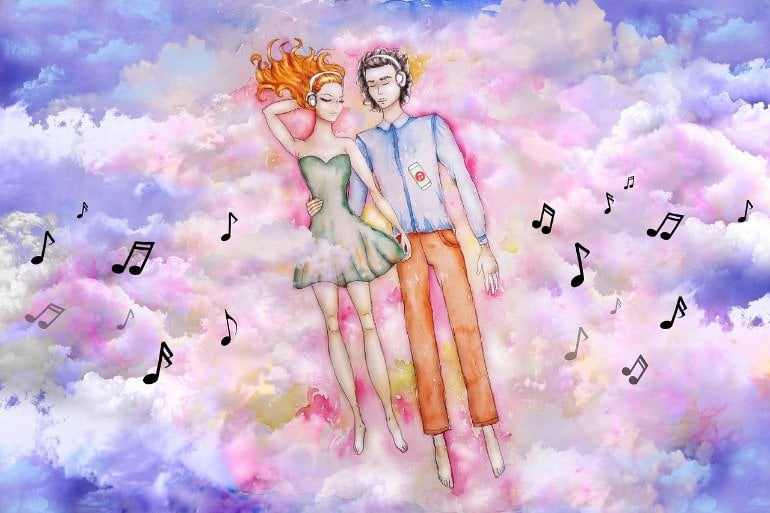Summary: Metaphors represent over 70% of figurative language used to convey love and emotion in pop music. Over two-thirds of love songs reflect the correlation between physical proximity and possession.
Source: UOC
In both life and music, the secret to success is love. This universal emotion stands out as the key protagonist in the most listened-to songs of all time. According to a study by Salvador Climent Roca and Marta Coll-Florit from the GRIAL applied linguistics research group (tied to the UOC Faculty of Arts and Humanities), love is central to 52 of the 71 songs that topped the Billboard magazine’s year-end charts from 1946 to 2016. “Pop music is created to achieve commercial success, and evocations of feelings of love and unrequited love are powerfully attractive for all types of audiences,” said the authors.
Their analysis, published in open access in the Text and Talk journal, explores an area little explored by academics: pop music. “Few studies have qualitatively analysed the discourse reflected in the lyrics of hit songs. This kind of analysis helps us study social trends on a large scale,” explained Climent Roca. The study analysed the lyrics of the songs most listened to in the USA over seven decades to explore how conceptions of love have changed over time.
The study indicates that metaphors represent over 70% of the figurative language used to express feelings of romantic love in pop music. “This observation corresponds to theoretical predictions that indicate that much of our thinking relies on metaphorical language, as metaphor helps us to effectively express concepts and complex emotions,” said Coll-Florit. By analysing the metaphors used most often, we can see how love and associated feelings and experiences have been conceptualized over the years.
Metaphors for talking about love
Starting with the smoochy “Prisoner of Love” by Perry Como and ending with the viral hit “Love Yourself” by Justin Bieber, the journey through the most popular love songs of each era also reveals that the way we talk about love has changed in recent history. According to the analysis by Climent Roca and Coll-Florit, each of the songs analysed uses metaphor to speak of love. Among the hundreds of love metaphors used most, those that refer to love as proximity, possession, union, physical contact, captivity or as a journey stand out. It is also common to speak of the loved one as ‘baby’ or in terms of appetizing food.

Three quarters of the most popular songs about love refer to romantic love, while the rest have erotic themes. Put in perspective, the analysis reflects a curious phenomenon. From the 1970s, US pop music has used more sensual and explicit metaphors to talk about love. The analysis shows that songs with erotic themes are concentrated between 1977 and 1982, featuring in the six songs most listened to each year. Another boom in explicitly sensual songs occurs between 1996 and 2008, with five such hit songs in those 13 years. The analysis also reveals that 14 of the 15 songs listened to most between 1983 and 2016 refer to the anguish of love.
From physical proximity to possession
Many of the songs refer to love in terms of physical proximity: from the desire to be near the loved one to the contact of fusion between lovers. Many other songs speak of love in terms of possession or captivity. At least a score of the most popular love songs depict an unequal love relationship, in which one of the lovers considers the other to belong to them. In several cases, love is reflected as yet another form of subjugation. Just over two thirds of the songs, in fact, reflect a correlation between metaphors of physical proximity and of possession; in other words, both ideas seem to overlap.
“It’s normal that physical proximity metaphors, as emerging naturally from love relationships, would be used in love songs. Metaphors of possession, on the other hand, reflect a cliché deeply rooted in popular culture,” said Climent Roca and Coll-Florit. Their “All you need is love” study invites us to look beyond the catchy melodies and gain a deeper understanding of lyrics that we have all joined in with at one time or another, singing our hearts out in accompaniment.
About this language research news
Source: UOC
Contact: Sònia Armengou – UOC
Image: The image is in the public domain
Original Research: Open access.
“All you need is love: Metaphors of love in 1946–2016 Billboard year-end number-one songs” by Salvador Climent and Marta Coll-Florit. Text and Talk
Abstract
All you need is love: Metaphors of love in 1946–2016 Billboard year-end number-one songs
This study examines the use of metaphors, metonymies and metaphorical similes for love in a selective corpus of the most commercially successful US hit songs from 1946 to 2016 according to Billboard year-end charts. The analysis is performed within the framework of Conceptual Metaphor Theory and from quantitative and qualitative perspectives. Our results indicate that the theme of romantic love is prevalent in US mainstream pop music over the course of seven decades but shows evolutionary features. Metaphors of love evolve from conventional to novel with a notable increase in both heartbreak and erotic metaphors. Remarkably, the study finds that the two predominant conceptualizations of love in pop songs – which in a significant number of cases overlap – are the following: one experiential, originating in the physical proximity of the lovers, and one cultural, reflecting possession by one lover and showing a non-egalitarian type of love.






